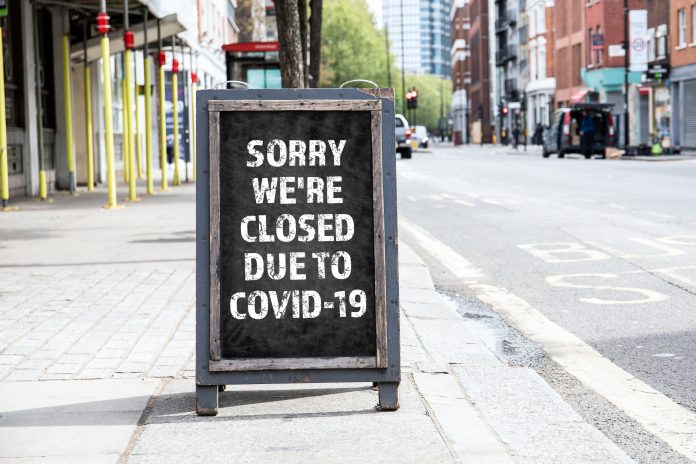John Bell, director and founder of Clarke Bell, ponders the impact of COVID-19 on the economy and what options struggling businesses could be facing in the coming months and years ahead
Thousands of businesses large and small have been impacted by the global COVID-19 pandemic throughout the past 12 months. With many having to adapt and alter how they operate or stop trading altogether, it has been a turbulent time for a lot of company directors.
The economy as a whole has been weakened by the pandemic, with global economic growth almost at a standstill at the end of 2020.
It is expected that global insolvencies could increase by 25% at the end of 2021. So, many businesses will be worried about the knock-on effects of the pandemic and how it might impact them in coming months.
COVID-19 knock-on effects on the UK economy
In 2020 GDP declined by 9.9% which is more than twice the fall in 2009. Although there were signs of recovery during December 2020 when GDP rose by 1.2%, it remained 6.3% below February 2020 levels.
At the end of last year, the UK entered into a double-dip recession following on from the effects of the first and second national lockdowns.
What has this meant for businesses?
Since last March only a limited number of businesses have been able to continue operating in bricks and mortar premises including essential retail, financial services, repair services and vehicle services.
Many other businesses have had to temporarily close, operate only online or on a click and collect basis.
Some sectors have been more badly hit than others, with hospitality, hotels, pubs, beauty and cafes being amongst the worst impacted. Some areas of retail have also been badly impacted, with sales of clothing and footwear falling, with rates remaining below February 2020 levels.
Entertainment providers such as cinemas and theatres have also been badly impacted, with trade down to just 10% of what it was before the pandemic. Even when cinemas were allowed to temporarily re-open in September 2020, due to social distancing rules their turnover was still down by 58%.
Knock on effects of COVID on business liquidation
The percentage of businesses reporting a zero turnover during December 2020 was 7.7%, an improvement on the 8.1% reported in November 2020 but higher than the pre-pandemic level of 6.1%.
The pandemic has caused a liquidity shortfall for thousands of businesses across the UK, meaning many have failed to meet their debt payment obligations and pushing many into insolvency.
Although some have been more badly impacted than others, many businesses have been able to stay afloat due to the range of government fiscal support made available such as bounce back loans for businesses and the Coronavirus Business Interruption Loan Scheme.
However, it is anticipated that business insolvency is likely to increase in the medium and long terms.
Even following the COVID vaccination rollout which promises to bring a ‘return to normalcy’ with the easing of social distancing rules, it is assumed that many businesses will still enter into insolvency proceedings.
If your business has been badly impacted by the knock-on effects of the pandemic and recovery doesn’t seem like a viable route forward, then it might be time to know what your options are.
Liquidation
A company that is insolvent is one that is no longer sustainable and can’t cover its daily costs, bills or debts. Whether your company is experiencing financial difficulties or can be deemed insolvent, the sooner you act the more options will remain open to you.
These include:
Creditors’ Voluntary Liquidation (CVL)
A CVL is a completely voluntary form of liquidation that is initiated by the company directors and shareholders.
The process is usually started when a business can no longer afford to pay their bills or meet their debt obligations.
The CVL must be carried out and overseen by a licensed Insolvency Practitioner. It is a process under which the company’s assets are sold and any realisation is distributed to the company’s creditors.
The final stage of the CVL is that a company is dissolved, meaning it ceases to trade and operate, and is struck off the registrar of companies.
Why consider a CVL?
There are several benefits for both directors and creditors using a CVL:
- This is a good option for directors who want to take control of their situation and act before things get any worse for their business.
- As a voluntary process, directors are free to choose which Insolvency Practitioner they appoint to carry out the CVL.
- The director can close their business but always has the option to open another business in the future.
- By opting for CVL, directors can avoid their company being forced into compulsory liquidation which is the most serious type of liquidation.
Entering into Creditors’ Voluntary Liquidation can be one way to avoid being forced into compulsory liquidation.
This is when a company is forced to close by creditors who are unable to recover debts they are owed of more than £750.
In this case, the creditors can issue a statutory payment demand notice, giving the company 21 days to pay back the amount owed.
Or creditors can go directly to the courts and issue a winding-up petition by using a pre-winding up demand letter (instead of a formal statutory demand) to evidence inability to pay, and then proceed with the petition if the debt is not disputed.
If the court decides that your company should be wound up it will be forced to close and will enter liquidation.
There are challenging times ahead as we emerge from the pandemic. Facing up to the challenges is the first necessary step to taking control of a difficult financial situation and with proper professional advice and support it needn’t be a daunting prospect and will help you to move on.











